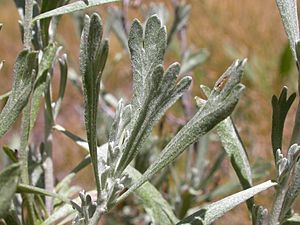Timberline sagebrush facts for kids
Artemisia rothrockii, also known as timberline sagebrush or Rothrock's sagebrush, is a special plant found in North America. It's a type of sagebrush, which is a group of plants known for their strong smell.
Quick facts for kids Timberline sagebrush |
|
|---|---|
 |
|
| Conservation status | |
| Scientific classification | |
| Genus: |
Artemisia
|
| Species: |
rothrockii
|
| Synonyms | |
|
|
Contents
Discovering Rothrock's Sagebrush
Where Rothrock's Sagebrush Lives
Artemisia rothrockii is a plant that is endemic to California. This means it naturally grows only in California and nowhere else in the world! You can find it in parts of the Sierra Nevada, the White Mountains, and the San Bernardino Mountains.
It has been seen in places like the Golden Trout Wilderness, Mount Dana, Angora Peak, and near Fallen Leaf Lake. This sagebrush likes to grow in dry areas. These are often found between mountain meadows and forests. It can also handle wet conditions, even surviving when water covers the ground during snowmelt.
High Mountain Homes
This mountain shrub grows at very high elevations. You can find it between 2,000 and 3,500 meters (about 6,500 to 11,500 feet) above sea level.
What Rothrock's Sagebrush Looks Like
Artemisia rothrockii is a small shrub, usually growing to be 20 to 50 centimeters (about 8 to 20 inches) tall. It has many stems that grow straight up from a narrow base.
Leaves and Smell
The leaves of this plant stay green all year round. They are dark green, sticky, and have a very strong, pleasant smell. When new twigs and leaves first grow, they might feel a bit fuzzy. But as they get older, they become smooth and hairless.
Flowers and Seeds
The plant produces narrow groups of flower heads. These flower heads are lined with rough, shiny, slightly hairy leaf-like parts called phyllaries. Inside the flower heads, you'll find yellowish disc florets.
After the flowers bloom, the plant produces small fruits called achenes. These are tiny, up to 2 millimeters long. Sometimes, these fruits have a small, feathery top called a pappus, which helps them float in the wind.
Who Was Rothrock?
The species is named after an American forester named Joseph Trimbel Rothrock. He lived from 1839 to 1922. Scientists often name new plants or animals after the people who helped discover or study them.


